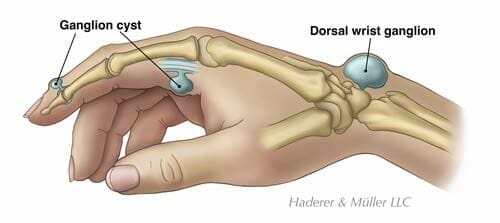Ganglion Cyst of the Wrist and Hand
Patient Information
Overview
Ganglion cysts are the most common mass or lump in the hand. They most frequently develop on the back of the wrist but can occur in many other locations. These fluid-filled cysts can quickly appear, disappear and change size. They are not cancerous, often harmless and require no treatment. However, if the cyst is painful, interferes with function, or has an unacceptable appearance, there are several treatment options available.
Description
A ganglion cyst rises from a joint and grows out of the tissues surrounding, such as ligaments, tendon sheaths, and joint linings. Inside the cyst is a thick, jelly-like fluid, called the “synovial fluid” that lubricates the joints.
Ganglion cysts can develop in several of the joints in the hand and wrist, including both the top and underside of the wrist, as well as the end joint of a finger, and at the base of a finger. They vary in size, and in many cases, grow larger with increased wrist activity. With rest, the lump typically becomes smaller.
Cause
It is unclear what triggers the formation of a ganglion. However, they are common in people who possess these factors:
- Most common in younger people between the ages of 15 and 40 years
- Women are more likely to be affected than men
- Gymnasts or those who repeatedly apply stress to the wrist
Ganglion cysts that develop at the end joint of a finger, also known as mucous cysts, are typically associated with arthritis in the finger joint, and are more common in women between the ages of 40 and 70 years.
Symptoms
Most ganglions form a visible lump, however, smaller ganglions can remain hidden under the skin (occult ganglions). Most ganglions produce no symptoms. However, if a cyst puts pressure on the nerves that pass through the joint, it can cause pain, tingling, and muscle weakness. Large cysts, even without symptoms, can cause concerns about appearance.
Doctor Examination
Medical History and Physical Examination
During the initial appointment, your doctor will discuss your medical history and symptoms. He or she may ask how long you have had it for, any changes in size and if you experience any pain. Pressure may be applied to check for tenderness. Because a ganglion cyst is filled with liquid, your doctor may shine a penlight to the cyst to see if any light shines through.
Imaging Tests
- Your doctor may order an imaging test, such as X-rays to rule out other conditions. Although x-rays will not show a ganglion cyst, it can eliminate arthritis or bone tumor.
- Magnetic resonance imaging (MRI) scans or ultrasounds: These imaging tests are better at examining soft tissues like a ganglion. Sometimes, an MRI or ultrasound is needed to find an occult ganglion that is not visible, or to distinguish the cyst from other tumors.
Treatment
Nonsurgical Treatment
Initial treatment of a ganglion cyst is not surgical.
Observation: Because the ganglion is not cancerous and may disappear on its own, if you do not have symptoms, your doctor may recommend just waiting and monitoring to make sure that no unusual changes occur.
Immobilization: Activity often causes the ganglion to increase in size and increases pressure on nerves, causing pain. A wrist brace or splint may relieve symptoms and cause the ganglion to decrease in size. As pain decreases, your doctor may prescribe exercises to strengthen the wrist and improve range of motion.
Aspiration: The fluid may be drained from the cyst if it causes severe pain or limits activities. This procedure is called an “aspiration,” which is performed with a needle punctured through the outer layer of the cyst to withdraw as much fluid as possible. However, aspiration often do not permanently eliminate the ganglion because the “root” connected to the joint or tendon sheath is not removed. Aspiration procedures are most effective and frequently recommended for ganglions located on the top of the wrist.
Surgical Treatment
Your doctor may recommend surgery if your symptoms are not relieved by nonsurgical methods, or if the ganglion returns after aspiration. The procedure to remove a ganglion cyst is called an excision, where the cyst and part of the involved joint capsule or tendon sheath (the root) is removed. Excision is typically an outpatient procedure and patients are able to go home after a period of observation in the recovery area. Following the surgery, you will wear a splint on the wrist for a few days. Your doctor may also recommend therapy to mobilize and trengthen the joints.
Recovery
Generally, there may be some tenderness, discomfort, and swelling after surgery. Each patient recovers at different rate, depending on the size of the cyst and the extent of the surgery. Typically, it takes about 2 to 6 weeks after surgery to resume to normal activities. Even after excision, there is a small chance the ganglion will return. However, most people are satisfied with the successful results.
References:
OrthoInfo. (2020). Diseases and conditions: Ganglion cyst of the wrist and hand. Retrieved from https://orthoinfo.aaos.org/en/diseases–conditions/ganglion-cyst-of-the-wrist-and-hand/
Watauga Orthopaedics. (2020). Ganglion cysts: Wrist/hand lumps and bumps. Retrieved from https://www.wataugaortho.com/PatientEducation?ctl=View&mid=81675&ContentPubID=90


